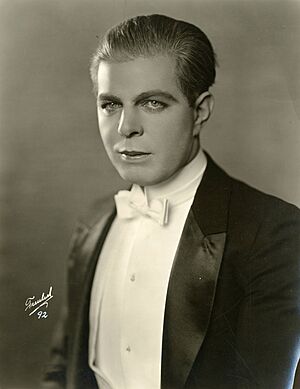Hoot Gibson facts for kids
Quick facts for kids
Hoot Gibson
|
|
|---|---|

Gibson, c. 1922
|
|
| Born |
Edmund Richard Gibson
August 6, 1892 Tekamah, Nebraska, U.S.
|
| Died | August 23, 1962 (aged 70) |
| Resting place | Inglewood Park Cemetery, Inglewood, California |
| Other names | Ed "Hoot" Gibson Edward Gibson Hall Gibson Ed Hall |
| Occupation |
|
| Years active | 1910–1960 |
| Spouse(s) |
Helen Johnson
(m. 1922; div. 1930)Dorothea Dunstan
(m. 1942) |
| Children | 1 |
Edmund Richard "Hoot" Gibson (born August 6, 1892 – died August 23, 1962) was a famous American rodeo champion. He also became a well-known film actor, director, and producer. Hoot Gibson started out doing stunts and acting as a side job. But he soon became a top star in Hollywood's growing cowboy movie scene.
Between World War I and World War II, Hoot Gibson was almost as popular as the legendary cowboy actor Tom Mix. He has a special star on the Hollywood Walk of Fame. He was also honored in the Hall of Great Western Performers at the National Cowboy & Western Heritage Museum.
Contents
Early Life and His Famous Nickname
Where Hoot Gibson Grew Up
Edmund Richard Gibson was born in Tekamah, Nebraska, on August 6, 1892. He learned to ride horses when he was a very young boy. When he was seven years old, his family moved to California. As a teenager, he worked with horses on a ranch. This led him to compete in rodeos, riding wild bucking broncos.
How He Got the Name "Hoot"
His co-workers first called him "Hoot Owl." This nickname later became simply "Hoot." Hoot Gibson himself once said on a TV show that he got the name "Hoot" because he used to look for hoot owls in caves when he was a child in Nebraska.
Becoming a Rodeo and Movie Star
Rodeo Champion
Even as he started acting, Gibson kept competing in rodeos to earn a living. In 1912, he won the all-around championship at the famous Pendleton Round-Up in Oregon. He also won the steer roping world championship at the Calgary Stampede that same year.
Serving His Country
Hoot Gibson's career was paused when he joined the United States Army during World War I. He served as a sergeant in the Tank Corps. After the war, he went back to rodeos. He became good friends with Art Acord, who was also a cowboy and movie actor. They would compete in rodeos in the summer. Then, they would go to Hollywood in the winter to do stunt work for movies.
From Stunts to Leading Roles
For several years, Gibson had smaller roles in films, mostly Westerns. He worked with stars like Harry Carey. By 1921, cowboy movies were very popular. Gibson started getting offers for main roles. Some of these offers came from the rising film director John Ford. Gibson and Ford became lasting friends and often worked together.
Life After Fame
Movie Success and New Challenges
From the 1920s to the 1940s, Hoot Gibson was a huge movie star. He was the second most popular Western film actor, right after Tom Mix. He successfully moved from silent films to movies with sound. This made him a very highly paid performer. After leaving Universal Pictures, he made many successful films with Allied Pictures. He even had his own comic books. However, his popularity later faded when "singing cowboys" like Gene Autry and Roy Rogers became famous.
Adventures and Financial Troubles
In 1927, Gibson helped sponsor a plane called The Spirit of Los Angeles. This plane was meant to compete in the Dole Air Race. Gibson's name was painted on the plane for publicity. Sadly, the aircraft crashed before the race began. In 1933, Gibson was hurt when his plane crashed during a race against fellow cowboy star Ken Maynard. Later, these two friends made some low-budget movies together.
Hoot Gibson earned a lot of money during his successful years. However, he spent much of it on a fancy lifestyle and bad investments. By the 1950s, he faced money problems. This was partly due to high medical bills from serious health issues. To make ends meet, he worked as a greeter at a Las Vegas casino. He also worked in a carnival for a while. He took almost any job he could find. He even appeared on Groucho Marx's TV show, You Bet Your Life, in 1955.
Family Life
On September 6, 1913, Hoot Gibson married Rose August Wenger. She was also a rodeo performer. They met at the Pendleton Round-Up. Rose became a big movie star herself, known as Helen Gibson. She famously starred in The Hazards of Helen.
Gibson later married Helen Johnson on April 20, 1922. They had one child, Lois Charlotte Gibson. They later separated.
Hoot Gibson married film actress Sally Eilers on June 28, 1930. This marriage ended in 1933.
His final marriage was to Dorothy Dunstan, a yodeler, on July 3, 1942.
Death and Legacy
Hoot Gibson passed away from cancer on August 23, 1962, in Woodland Hills, California. He was 70 years old. He was buried in the Inglewood Park Cemetery in Inglewood, California.
Honors and Recognition
In 1960, Hoot Gibson received a star on the Hollywood Walk of Fame for his work in films. His star is located at 1765 Vine Street. In 1979, he was honored again. He was inducted into the Western Performers Hall of Fame at the National Cowboy & Western Heritage Museum in Oklahoma City, Oklahoma.
See also
 In Spanish: Hoot Gibson para niños
In Spanish: Hoot Gibson para niños


